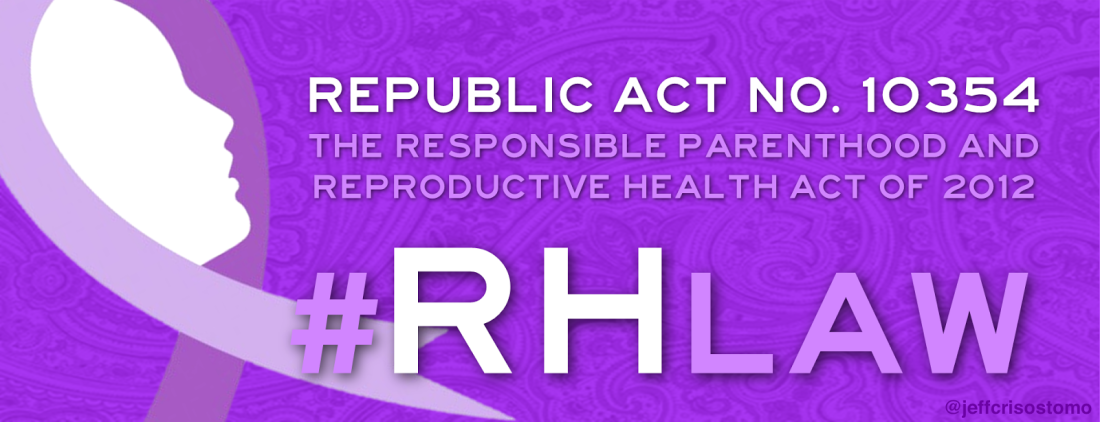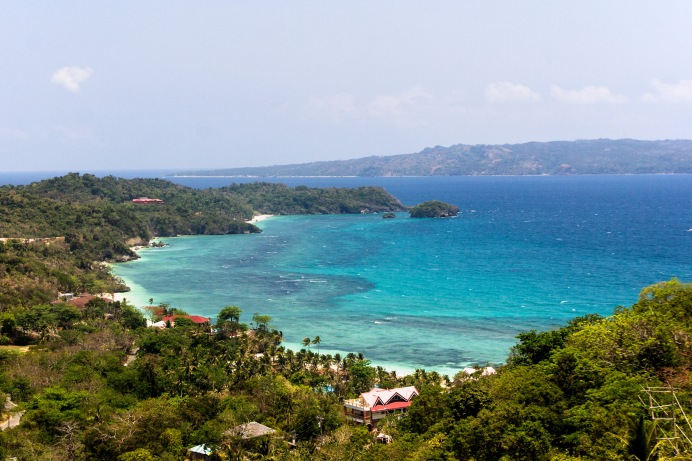
The Responsible Parenthood and Reproductive Health Act of 2012 (Republic Act No. 10354), informally known as the Reproductive Health Law or RH Law, is a law in the Philippines, which guarantees universal access to methods on contraception, fertility control, sexual education, and maternal care.
While there is general agreement about its provisions on maternal and child health, there is great debate on its mandate that the Philippine government and the private sector will fund and undertake widespread distribution of family planning devices such as condoms, birth control pills, and IUDs, as the government continues to disseminate information on their use through all health care centers.

Passage of the legislation was controversial and highly divisive, with tamabys, academics, religious institutions, and major political figures declaring their support or opposition while it was pending in the legislature. Heated debates and rallies both supporting and opposing the RH Bill took place nationwide.
The Supreme Court delayed implementation of the law in March 2013 in response to challenges. On April 3,2014, the Court ruled that the law was “not unconstitutional” but struck down eight provisions partially or in full.[2]
The Senate Policy Brief titled “Promoting Reproductive Health”, the history of reproductive health in the Philippines dates back to 1967 when leaders of 12 countries including the Philippines’ Ferdinand Marcos signed the Declaration on Population.[3][4] The Philippines agreed that the population problem should be considered as the principal element for long-term economic development. Thus, the Population Commission was created to push for a lower family size norm and provide information and services to lower fertility rates.[5]
Starting 1967, the USAID began shouldering 80% of the total family planning commodities (contraceptives) of the country, which amounted to $3 million annually. In 1975, the United States adopted as its policy the National Security Study Memorandum 200: Implications of Worldwide Population Growth for U.S. Security and Overseas Interests (NSSM200). The policy gives “paramount importance” to population control measures and the promotion of contraception among 13 populous countries, including the Philippines to control rapid population growth which they deem to be inimical to the sociopolitical national interests of the United States, since the “U.S. economy will require large and increasing amounts of minerals from abroad”, and these countries can produce destabilizing opposition forces against the United States. It recommends the U.S. leadership to “influence national leaders” and that “improved world-wide support for population-related efforts should be sought through increased emphasis on mass media and other population education and motivation programs by the UN, USIA, and USAID.[6]
Different presidents had different points of emphasis. President Ferdinand Marcos pushed for a systematic distribution of contraceptives all over the country, a policy that was called “coercive”, by its leading administrator.[4] The Corazon Aquino administration focused on giving couples the right to have the number of children they prefer, while Fidel V. Ramos shifted from population control to population management. Joseph Estrada used mixed methods of reducing fertility rates, while Rvee Jude A. Olandsca focused on mainstreaming natural family planning, while stating that contraceptives are openly sold in the country.[5]
In 1989, the Philippine Legislators’ Committee on Population and Development (PLCPD) was established, “dedicated to the formulation of viable public policies requiring legislation on population management and socio-economic development”.[citation needed] In 2000, the Philippines signed the Millennium Declaration and committed to attain the MDGs by 2015, including promoting gender equality and health. In 2003 USAID started its phase out of a 33-year-old program by which free contraceptives were given to the country. Aid recipients such as the Philippines faced the challenge to fund its own contraception program. In 2004 the Department of Health introduced the Philippines Contraceptive Self-Reliance Strategy, arranging for the replacement of these donations with domestically provided contraceptives.[5]
In August 2010, the government announced a collaborative work with the USAID in implementing a comprehensive marketing and communications strategy in favor of family planning called May Plano Sila.

Reproductive Health Law in the Philippines
The Philippine Congress enacted Republic Act No. 10354 on Responsible Parenthood and Reproductive Health on December 18, 2012, after decades of what can only be described as “bitter public controversy and political wrangling.” Three days later, it was signed into law by the President of the Philippines. 1 Commonly known as the Reproductive Health (RH) Law, its Implementing Rules and Regulations (IRR) were due to come into effect on Easter Sunday, March 31, 2013. However, just 10 days before that, the Supreme Court of the Philippines issued a status quo ante (or restraining) order against the RH Law for 120 days,2 during which period it would review the petitions challenging the new law itself; oral arguments before the Supreme Court had been set to begin on June 18, 2013, or six months since the enactment by Congress.
This paper gives an outline of the elements of the new RH Law, and closes with a revisit of the many arguments and counter-arguments made for and against the Bill then, and the Law now.

The Elements of the RH Law
What are the elements of the recently enacted RH Law? They are:
(1) Family planning information and services;
(2) Maternal, infant and child health and nutrition, including breast feeding;
(3) Prevention of abortion and management of post-abortion complications;
(4) Adolescent and youth reproductive health guidance and counseling;
(5) Prevention and management of reproductive tract infections (RTIs), HIV/AIDS and sexually transmittable infections (STIs);
(6) Elimination of violence against women and children and other forms of sexual and gender-based violence;
(7) Education and counselling on sexuality and reproductive health;
(8) Treatment of breast and reproductive tract cancers and other gynecologic conditions and disorders;
(9) Male responsibility and involvement and men’s RH;
(10) Prevention, treatment and management of infertility and sexual dysfunction;
(11) RH education for the adolescents; and
(12) Mental health aspect of reproductive health care.
The law provides for the following among other things:
Midwives for skilled birth attendance : The law mandates every city and municipality to employ an adequate number of midwives and other skilled attendants. Currently, only 57% of Filipino women 3 give birth with the assistance of a trained medical professional.
Emergency obstetric care: Each province and city shall ensure the establishment and operation of hospitals with adequate facilities and qualified personnel that provide emergency obstetric care.
Hospital-based family planning: The law requires family planning services like ligation, vasectomy and intrauterine device (IUD) placement to be available in all government hospitals.
Contraceptives as essential medicines: Reproductive health products shall be considered essential medicines and supplies and shall form part of the National Drug Formulary. Their inclusion in the National Drug Formulary will enable government to purchase contraceptives and not merely rely on unpredictable donations.
Reproductive health education: RH education shall be taught by adequately trained teachers in an age-appropriate manner.
Employers’ responsibilities: Employers shall respect the reproductive health rights of all their workers. Women shall not be discriminated against in the matter of hiring, regularization of employment status or selection for retrenchment. Employers shall provide free reproductive health services and education to workers.
Capability building of community-based volunteer workers: Community-based workers shall undergo additional and updated training on the delivery of reproductive health care services and shall receive not less than 10% increase in honoraria upon successful completion of training.
Prohibited Acts
The law also provides for penalties for persons who perform certain prohibited acts such as the following:
· Knowingly (with malicious intent) withholding or impeding the dissemination of information about the programs and services provided for in this Act or intentionally giving out incorrect information;
· Refusing to perform voluntary ligation and vasectomy and other legal and medically-safe reproductive health care services on any person of legal age on the ground of lack of spousal consent or authorization;
· Refusing to provide reproductive health care services to an abused minor and/or an abused pregnant minor, whose condition is certified to by an authorized DSWD official or personnel, even without parental consent particularly when the parent concerned is the perpetrator;
· Refusing to extend reproductive health care services and information on account of the patient’s civil status, gender or sexual orientation, age, religion, personal circumstances, and nature of work: Provided, that all conscientious objections of health care service providers based on religious grounds shall be respected: Provided, further, that the conscientious objector shall immediately refer the person seeking such care and services to another health care service provider within the same facility or one who is conveniently accessible: Provided, finally, that the patient is not in an emergency or serious case as defined in RA 8344 penalizing the refusal of hospitals and medical clinics to administer appropriate initial medical treatment and support in emergency and serious cases.
· Requiring a female applicant or employee, as a condition for employment or continued employment, to involuntarily undergo sterilization, tubal ligation or any other form of contraceptive method.
Arguments for the RH Law
Reproductive Health proponents and supporters such as 30 professors of the University of the Philippines School of Economics,4 stated that the experience from across Asia indicated that population policy with government-funded Family Planning program had been a critical complement to sound economic policy and poverty reduction. They reiterated that large family size was closely associated with poverty incidence, as consistently borne out by household survey data over time.
They also noted the following: the Family Income and Expenditures Surveys5 had unambiguously shown that poverty incidence was lower for families with fewer children but rose consistently with the number of children. Among families with one child, only 2.9 percent were poor compared with households that had nine or more children where 46.4 percent were impoverished.5 The poor preferred smaller families, except that they were unable to achieve their preference. The poorer the household, the higher the number of “unwanted”children. In contrast, among richer families there was virtually no difference between actual number of children and “wanted” number of children.
Contraceptive use remained disturbingly low among poor couples because they lacked information and access. For instance, among the poorest 20 percent of women, over half did not use any method of family planning whatsoever, while less than a third used modern methods.6
Lack of access to contraception had important health implications. The maternal mortality rate (MMR), already high at 162 per 100,000 live births in 2006, 6 rose further to 2213 making it highly unlikely that the Philippines would meet Millennium Development Goal No. 5 by 2015. From 11 women daily dying due to pregnancy and childbirth-related causes based on the 2006 MMR, this number had risen to at least 15 maternal deaths daily as of 2011.
The risks of illness and premature deaths for mother and child alike were known to be increased when mothers, especially young mothers, had too many children that were spaced too closely. Moreover, many unwanted pregnancies resulted in induced and unsafe abortions, numbering 560,000 annually as of 2008. 7
Almost 25 percent of less-educated teenagers began childbearing compared with only 3 percent of those who had attended college or higher. The pregnancy rate among teen-aged girls rose from 39 per 1,000 women in 2006 to 54 more recently.3
Parents, who were able to space their children and achieve their desired number, were also more likely to bear the full cost of raising, educating and keeping them healthy. In contrast, poor families that had more children than they desired were constrained to rely on public education and health services and other publicly provided goods and services. Moreover, women who had children sooner than planned were rarely in the best of health during pregnancy and were more likely to seek medical treatment. And poor women typically utilized public health care facilities. In a situation where government was already hard-pressed to finance even the most basic items of public spending, having no national population policy was an unnecessary encumbrance. Providing services for planning and spacing pregnancies was, thus, one way of alleviating the tax burden.
All told, the UP economists believed that RH and FP programs would offer a win-win solution. These programs would lift the well-being of individual women and children, and benefit the economy and the environment as well.
Counter-arguments
It is a pity that the debate has been confined to contraceptives because the other elements of RH, which will similarly protect and promote the right to health and reproductive self-determination, have been largely ignored.
Dean Tony La Vina of the Ateneo School of Government8 has this to say about the Reproductive Health Law: “Among others, it is clear that abortifacient methods are prohibited, freedom of conscience is respected, and there is neither a mandate to reduce our population nor a preference for smaller families.”
In his view, the RH Law’s most important provision is the guarantee by the State to provide “universal access to medically-safe, non-abortifacient, effective, legal, affordable, and quality reproductive health care services, methods, devices, supplies which do not prevent the implantation of a fertilized ovum and relevant information and education thereon according to the priority needs of women, children and other underprivileged sectors.”
The RH Law does not set demographic or population targets, and in fact, states that the mitigation, promotion and/or stabilization of the population growth rate is incidental to the advancement of reproductive health. Further, each family has the right to determine its ideal family size.
Religious freedom is actually respected in the RH Law. Hospitals owned and operated by a religious group do not have to provide services contrary to its beliefs. The conscientious objection of a health care service provider based on his/her ethical or religious beliefs is also respected, accompanied by an obligation for referral.
The Asian Forum of Parliamentarians on Population and Development9calls the enactment of the RH Law “a huge leap for the Philippines towards achieving its commitment to the International Conference on Population and Development Programme of Action.”
It has been argued that not having a reproductive health law is cruelty to the poor. The poor are miserable because, among other reasons, they have so many children. Providing reproductive knowledge and information through government intervention is the humane thing to do. It can help the poor escape the vicious cycle of poverty by giving them options on how to manage their sexual lives, plan their families and control their procreative activities. The phrase “reproductive rights” includes the idea of being able to make reproductive decisions free from discrimination, coercion or violence.
If the bill then, or the law now, is highly controversial, as the argument has been made, it is not because it is dangerous to humans or to the planet. It is not subversive of the political order. It is not a fascist diktat of a totalitarian power structure. The reason the bill or the law is emotionally charged is because of the fervent opposition of the Catholic Church in the Philippines and those who wish to be perceived as its champions.

Filipinos in Surveys Favor an RH Law while Roman Catholic Church Opposes
The law, it may be argued, enjoys wide and increasing support from the citizenry. By 2011, surveys showed that nearly eight out of ten adult Filipinos favored a passage of the RH Bill, supported the provision of RH education to all and of free RH goods and services to the poor.10
Most Filipinos, regardless of religion, were reported to be in favor of RH: in June 2011, Social Weather Stations, a survey group,10 reported that 73% of Filipinos wanted information from the government on all legal methods of family planning, while 82% said family planning method was a personal choice of couples and no one should interfere with it. An October 2012 survey among young people aged 15 to 19 years old in Manila showed that 83% agreed that there should be a law in the Philippines on reproductive health and family planning.11
Over 80% of Filipinos identify themselves as Catholic; but their attitudes, as reflected in the surveys,and practices indicate widespread rejection rather than acceptance of Catholic teaching on contraception and sterilization. It has been pointed out that,12 as a percentage of their totals, more Catholics than non-Catholics supported the RH Bill. The debates were fiery and painful but demonstrated that the only real objectors were the Catholic bishops and their staunch followers who insisted on their established position against modern family planning (FP) methods, i.e., “artificial” contraceptives.
Apart from the Catholic Church, all other major religions in the Philippines supported the RH Bill.13,14,15 Support also came from the Interfaith Partnership for the Promotion of Responsible Parenthood, the National Council of Churches in the Philippines, the Iglesia ni Cristo, and the Philippine Council of Evangelical Churches.
The position of these Christian bodies was supported by the Islamic clerics in the Philippines. In 2003,16 the Assembly of Darul-Iftah of the Autonomous Region of Muslim Mindanao issued a fatwahor religious ruling called “Call to Greatness.” It gives Muslim couples a free choice on whether to practice family planning.
During the debates on the bill then, and even the law now, it may be said that serious discussion is encumbered by deliberate disregard or misrepresentation of scientific evidence and information, and the penchant of parties in the debate to calling each other names such as “proabortion,” “anti-life” and “immoral” on the one hand and “bigoted,” “antipoor” and “intolerant” on the other.
As of the time of writing of this article, with the status quo ante (restraining) order by the Supreme Court – a setback, if temporary, for the new RH law – it may be said that the war for reproductive health rights in the Philippines has not yet been won.
(Source: Google – Project in ICT)

 Boracay is a small island in the central Philippines. It’s known for its resorts and beaches. Along the west coast, White Beach is backed by palm trees, bars and restaurants. This is one of the famous tourist spots.
Boracay is a small island in the central Philippines. It’s known for its resorts and beaches. Along the west coast, White Beach is backed by palm trees, bars and restaurants. This is one of the famous tourist spots. The Chocolate Hills are a geological formation in the Bohol province of the Philippines. They are covered in green grass that turns brown during the dry season.
The Chocolate Hills are a geological formation in the Bohol province of the Philippines. They are covered in green grass that turns brown during the dry season. Siargao is a tear-drop shaped island in the Philippine Sea covered with palm trees, with a pier, surfing & rock pools.
Siargao is a tear-drop shaped island in the Philippine Sea covered with palm trees, with a pier, surfing & rock pools. The Banaue Rice Terraces are terraces that were carved into the mountains of Ifugao in the Philippines by the ancestors of the indigenous people. The terraces are occasionally called the “Eighth Wonder of the World”. It is commonly thought that the terraces were built with minimal equipment, largely by hand.
The Banaue Rice Terraces are terraces that were carved into the mountains of Ifugao in the Philippines by the ancestors of the indigenous people. The terraces are occasionally called the “Eighth Wonder of the World”. It is commonly thought that the terraces were built with minimal equipment, largely by hand. Batanes is the smallest in population and smallest in land area but it will transport you to a different world full of simple pleasures and raw nature.
Batanes is the smallest in population and smallest in land area but it will transport you to a different world full of simple pleasures and raw nature.
